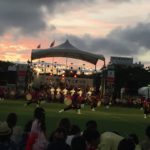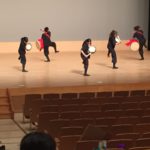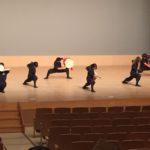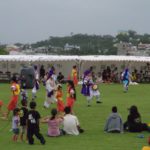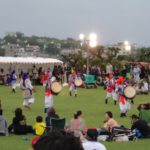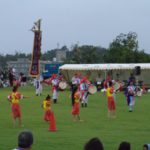「イーヤーサーサー」 “i-ya-sa-sa-”
「ハーイーヤー」 “ha-i-ya-”
This is the sound of eisa. Anyone who has lived in Okinawa will recognize it immediately.
As summer approaches, so does matsuri season. Eisa is a synonymous with the summer matsuri season here in Okinawa. Eisa エイサー is a type of “bon dance,” 盆踊り (bon odori). Bon, or Obon, (written in kanji as 御盆 or お盆) is an important time of year for Japanese people; it is a time to honor and commemorate their ancestors. They believe that each year during Obon, the ancestor spirits return to our world to visit relatives. Bon occurs the 13th through the 15th day of the 7th month of the year; for many places this is July (according to the solar calendar), however in Okinawa, it is celebrated according to the lunar calendar, so it occurs sometime in August or September. I will leave the details of customs and traditions related to Okinawan Obon holiday for another blog post, and for now focus on eisa. During Obon in Okinawa, many eisa troupes will perform all around the island to bid farewell as their ancestors leave to Earth to return again to the heavens. There is a local group that travels down our neighborhood and town, stopping at various points to perform; we are sure to watch them as they dance, chant, whistle, and play drums in front of the convenience store across the street.
Due to the large Japanese population in Hawai’i, Obon is also commonly celebrated all over Hawai’i throughout the summer months– so this holiday and bon dance in general is not really new to me, but I have learned about some of the more Okinawan traditions and especially eisa dance.
Although eisa originates as a bon dance, it is performed throughout the year and is considered an important aspect of Okinawan/Ryukuan culture. There are several eisa clubs around the island, and they are especially busy during the summer matsuri season. Already at my university they are practicing for summer during lunch and early afternoon, so I have some entertainment these days while I eat.
There are guys (and sometimes girls) playing larger (taiko) drums, as well as those with smaller hand drums. Usually the females are dressed in simple yukata with Ryukyuan designs. At least one of the guys will be dresses as “Chondara” (Okinawan clowns).
The role of the chondara is to cheer the dancers on and entertaining the audience, as well as guiding the group in the right direction. Sometimes also to scare the small children a bit.
The sounds of eisa wafting through the evening air, while sitting outside and drinking a beer sometimes feels a bit nostalgic as strange as that seems. It has that feeling, that summer has indeed arrived, and will soon be gone so be sure to enjoy the (hot and humid) weather now and the carefree feeling of lazy summer days, because soon it will be replaced by chilly fall and winter winds.
Preview some terribly taken videos of eisa:
https://youtu.be/JAM9VCQs2so
